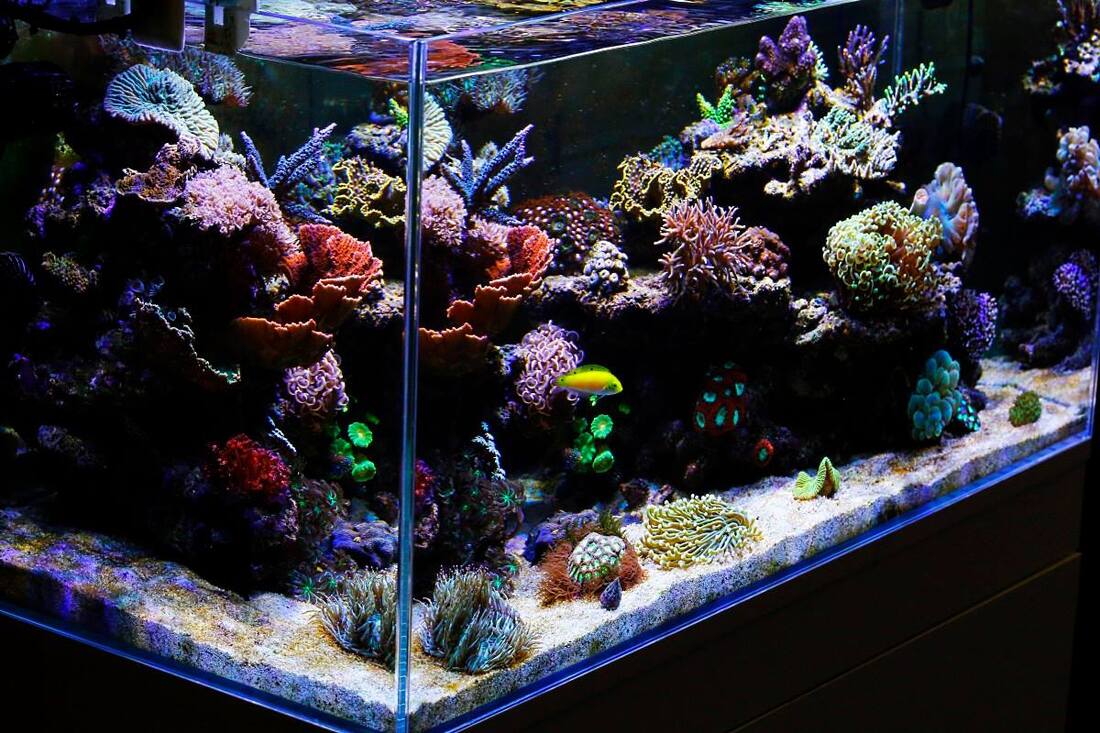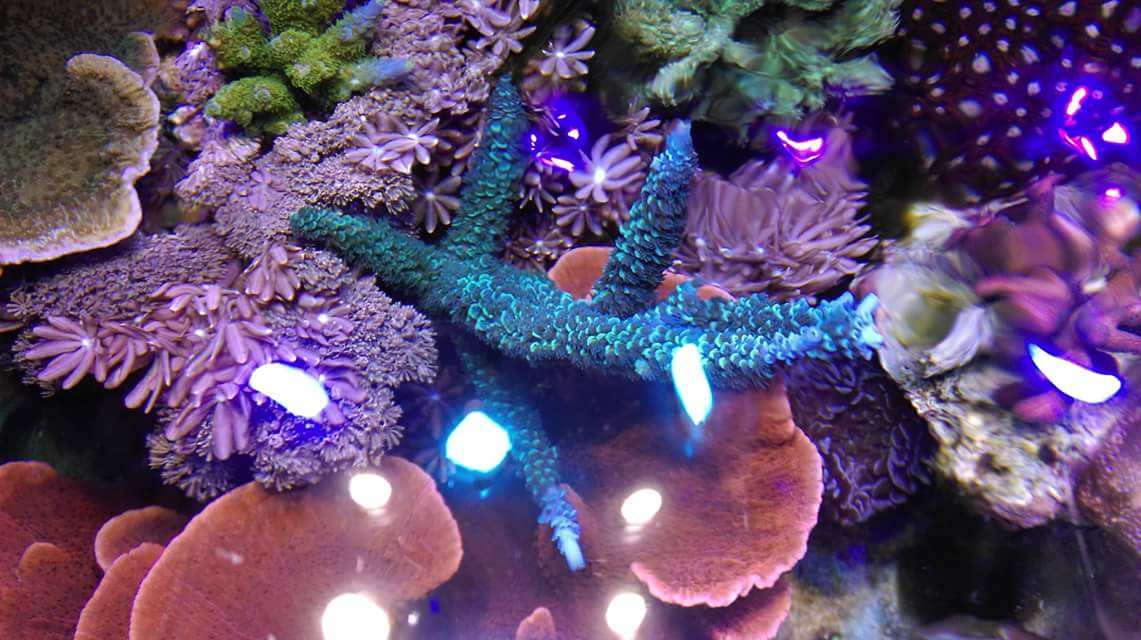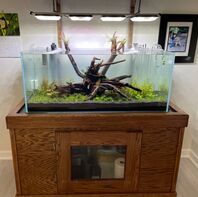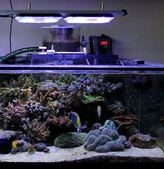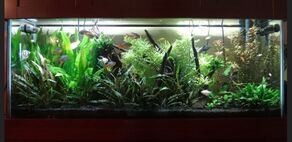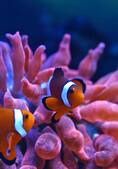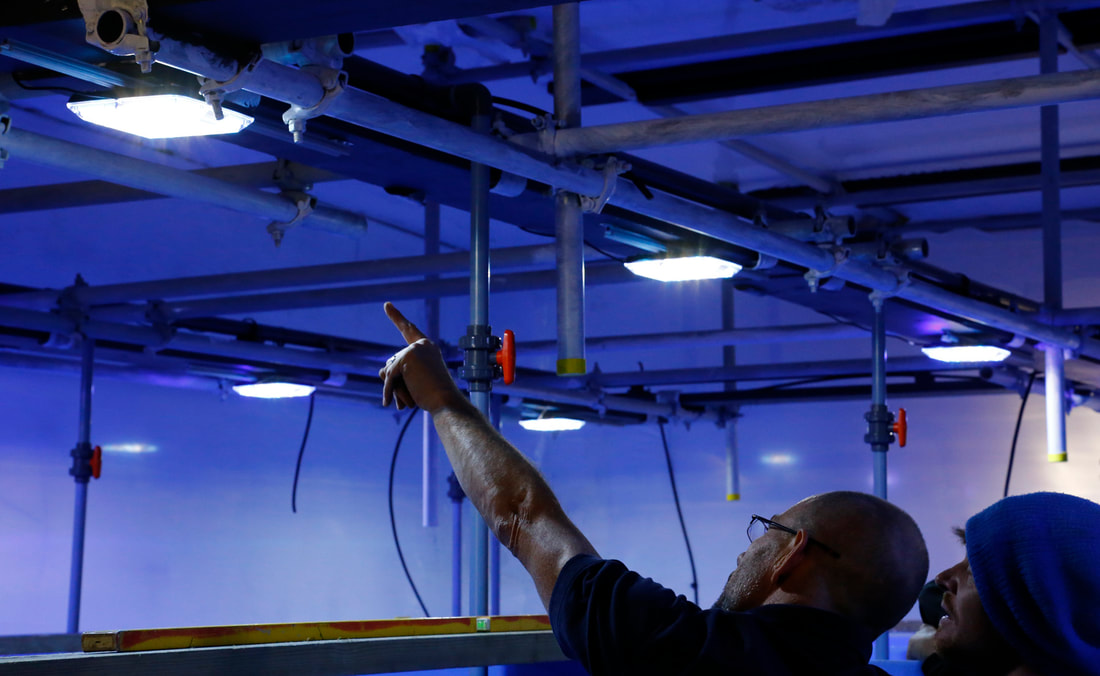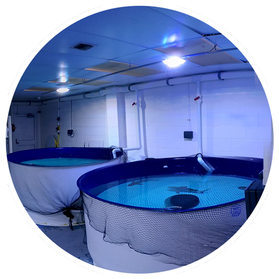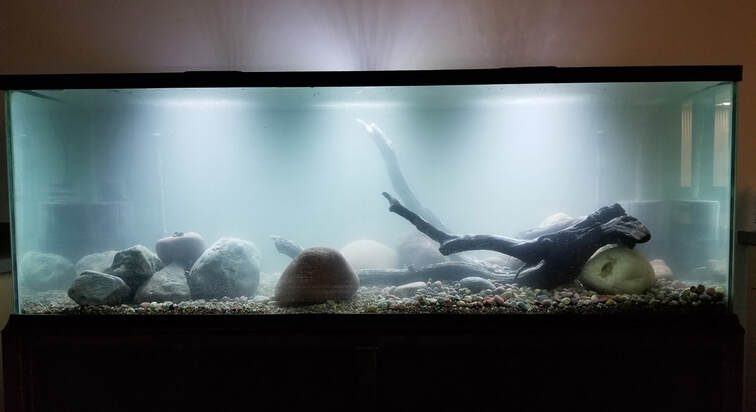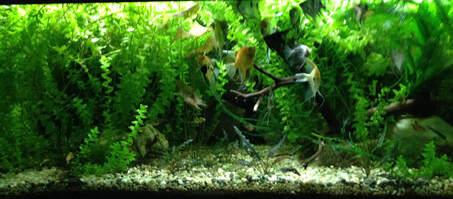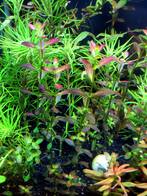Freshwater & Saltwater Aquarium Lighting
TMC AquaRay AquaBeam & GroBeam- Planted & Reef Premium
Aqueon Clip On-Power Compact
TMC AquaRay AquaBeam & GroBeam- Planted & Reef Premium
Aqueon Clip On-Power Compact
We're constantly researching LEDs, which includes real-world use.
We attempt to sell LEDs ONLY proven by researchable FACTS such as simple math to PROVE efficiency.
Which our conclusion is that long term, with longevity and efficiency factored in, AAP AquaRays are the best value in aquarium lighting!
This knowledge includes the importance of Photosynthetically Useful Radiation in relation to PAR output for both plants/corals, as per drivers/controllers & emitters used.
We attempt to sell LEDs ONLY proven by researchable FACTS such as simple math to PROVE efficiency.
Which our conclusion is that long term, with longevity and efficiency factored in, AAP AquaRays are the best value in aquarium lighting!
This knowledge includes the importance of Photosynthetically Useful Radiation in relation to PAR output for both plants/corals, as per drivers/controllers & emitters used.
Lighting Premium
Reef aquarium with Acropora coral using older generation TMC AquaRay 600 LEDs
National Oceanography Centre in London
National Oceanography Centre in London
Update: The TMC LED PWM controller has been discontinued in both USA and Europe. The LEDs are still available and still the highest standard of aquarium LED on the market.
At this time we recommend simple on/off timers for each separate channel on single power supplies. Also adjusting intensity by using channels and raising or lowing in mounting height.
At this time we recommend simple on/off timers for each separate channel on single power supplies. Also adjusting intensity by using channels and raising or lowing in mounting height.
Commerical Soultions
Lighting Economy
Below is a newly set up 200 gallon aquarium with just THREE of the standard AAP Clip-On LED Lights.
Add more or use the even brighter Planted Aquarium version (below) for economical powerful LED aquarium lights!
Add more or use the even brighter Planted Aquarium version (below) for economical powerful LED aquarium lights!
Power Compact
Mounting
The TMC AquaRay is far and away the most versatile reef or freshwater planted aquarium LED light when it comes no only to lighting choices, but also to the potential ways to mount.
Using the basic mounting hardware included, one can mount these lights in many different ways, especially with some imagination.
Once the unique and patented TMC mounting system is added to the equation, no other LED light comes even close to the potential possibilities for mounting!
Using the basic mounting hardware included, one can mount these lights in many different ways, especially with some imagination.
Once the unique and patented TMC mounting system is added to the equation, no other LED light comes even close to the potential possibilities for mounting!
Parts
Suggestions
Premium LEDs-
First, specimen or plant placement is key, for instance a generalized recommendation for 40 gallon planted tank would be (2) GroBeam 600s (24 watts total).
However, with just one 12 watt LED strip, one can still grow even high light plants well if placed directly under the lighting as per an employee here with just (1) GroBeam on his 40 gal. aquarium.
The Colour Plus 1500 alone or in combination with the GroBeam can be used for more red & other color.
Note that while the GroBeam Colour Plus provides more Red light spikes, the near perfect patented natural sunlight design of the GroBeam 1500 Daylight (6500K) is actually better for red plant growth, so only select the Colour Plus for personal preference.
Second as per LED lighting, these LED lights are so compact, that it is easy to add more light strips at a later time into your hood/canopy. So, even if you are unsure of the number of strips you will need or your budget is "tight", you can always add more later if your lighting requirements are not met.
Third "Watts Per Gallon? The commonly used formula is very outdated for comparing different light types. However, such a formula can still be used once figured for a SPECIFIC light system.
The formula below is for high end emitters used by TMC AquaRays in tanks under 20-24 inches in depth (25%+ higher wattage for deeper tanks). This "Watts Per Gallon" formula is ONLY for AquaRay LEDs, NOT other LEDs:
For Freshwater Fish only, .2 to .3 watt per gallon
For low to medium light planted freshwater aquarium or for saltwater fish only; .3 to .4 watt per gallon (or for Marine Fish Only).
For a high light planted freshwater aquarium .6 per gallon are required or for Reef "Softies"
For a SPS/LPS Reef Tank .8 per gallon generally works, in a tank under 20 inches.
However at 20" and above you will need to use more or at least a blend of focused lighting (such as the NP 2000), so this formula may need to increase to as high as 1.5 wpg in deeper tanks or Acropora.
Forth, The AAP AquaRay can also be combined with T5, T8, or Compact Fluorescents for budgetary or other reasons. HOWEVER due to heat issues, NO LED fixture should be combined with Metal Halide (this could void your warranty)!
• For Nano Aquariums, Fresh, or Saltwater (under 15 gallons)
(1) Mini 500 for all but the most delicate reef inhabitants or one Mini 400 for ANY high light planted aquarium.
• Small Aquariums (under 20 gal.) Often (1) GroBeam or AquaBeam 600 LED will work.
For planted FW or Reef needing more light consider (2) or complimenting an LED with a T5 or T8 fixture
The AquaRay Mini 400 or 500 are good choices and in fact the Mini 500 has excellent focused emitters, that lend to more depth penetration where as (2) would work well in a 20-30 gal. reef aquarium.
Consider an AquaBeam 2000 for a deeper Hex tank such as a 30 gallon for more light in a smaller tank "foot print".
(1) "1500 Ultima" or (2) "Reef White 600" would provide excellent lighting for a 29 gal/Bio Cube reef tank.
• For Medium Aquariums (such as a 60 gal.), generally (2) AquaRay 600 LEDs will work well for fish or medium light plants, however with higher light needs (sps corals, high light FW plants, etc.) consider (4) LED Strips (mixing LED types may be advisable too such as Reef White & Marine Blue for Reef Tanks).
(2) Ocean Blue NP Ultima or Coral Colour Plus would also be a good choice for a standard 60 or 75 gallon.
(2) of the GroBeam/Colour Plus 1500s can also be employed in planted 75 gallon tanks.
For tanks 22-30" in depth, the use of (1) Reef White 2000 to 1 Ocean Blue/Coral Colour+ 1500 can be employed (with specimen placement relative to overhead light).
The Mini 500 with more focused emitters then the 1500 but less than the 2000 could be used to balance out light spread with depth.
• (Advanced Reef): First keep in mind that Acropora are best placed at the top of your reef regardless of light used, not on the bottom. This is also where you highest water turbulence should be too.
An example of a 48"L x 15"w x 25"H aquarium (about 80 gal) would utilize (2)Reef White NP 2000 along with either (2) Reef White/Marine Blue 600 or for a more depth penetration but less light spread, (2) Mini 500s could be added to the 2000s.
As an example, a 125 gallon (6' tank) set up as a advanced Reef tank, you may want to consider a combination of (4) AquaBeam 2000 for light "hot spots" along with (3) 600 Ultimas.
Freshwater "High Light" Planted Freshwater:
One difference between the Reef & a High Light Planted Aquarium is if you are duplicating an Amazon River environment (Angels, Discus, Tetras, etc.) to consider that this habitat has many shaded areas and many Amazon fish prefer tanks that duplicate this.
Depth penetration is not quite as much an issue with freshwater aquariums, especially for freshwater tanks containing fish & plants from normally turbid or high tannin water.
To save on costs, use a household timer works perfectly fine with the AAP AquaRay lights. Multiple timers can be used to stagger on/off times. You simply will not have dimming or moonlight phases.
• If a household timer is used, make sure to use ONLY a grounded (3 prong) timer.
• IMPORTANT CARE: Make sure to provide both cross ventilation, not just a cut out in the back of a canopy & to wipe your fixture regularly to prevent moisture/humidity damage to circuitry that controls the emitters.
First, specimen or plant placement is key, for instance a generalized recommendation for 40 gallon planted tank would be (2) GroBeam 600s (24 watts total).
However, with just one 12 watt LED strip, one can still grow even high light plants well if placed directly under the lighting as per an employee here with just (1) GroBeam on his 40 gal. aquarium.
The Colour Plus 1500 alone or in combination with the GroBeam can be used for more red & other color.
Note that while the GroBeam Colour Plus provides more Red light spikes, the near perfect patented natural sunlight design of the GroBeam 1500 Daylight (6500K) is actually better for red plant growth, so only select the Colour Plus for personal preference.
Second as per LED lighting, these LED lights are so compact, that it is easy to add more light strips at a later time into your hood/canopy. So, even if you are unsure of the number of strips you will need or your budget is "tight", you can always add more later if your lighting requirements are not met.
Third "Watts Per Gallon? The commonly used formula is very outdated for comparing different light types. However, such a formula can still be used once figured for a SPECIFIC light system.
The formula below is for high end emitters used by TMC AquaRays in tanks under 20-24 inches in depth (25%+ higher wattage for deeper tanks). This "Watts Per Gallon" formula is ONLY for AquaRay LEDs, NOT other LEDs:
For Freshwater Fish only, .2 to .3 watt per gallon
For low to medium light planted freshwater aquarium or for saltwater fish only; .3 to .4 watt per gallon (or for Marine Fish Only).
For a high light planted freshwater aquarium .6 per gallon are required or for Reef "Softies"
For a SPS/LPS Reef Tank .8 per gallon generally works, in a tank under 20 inches.
However at 20" and above you will need to use more or at least a blend of focused lighting (such as the NP 2000), so this formula may need to increase to as high as 1.5 wpg in deeper tanks or Acropora.
Forth, The AAP AquaRay can also be combined with T5, T8, or Compact Fluorescents for budgetary or other reasons. HOWEVER due to heat issues, NO LED fixture should be combined with Metal Halide (this could void your warranty)!
• For Nano Aquariums, Fresh, or Saltwater (under 15 gallons)
(1) Mini 500 for all but the most delicate reef inhabitants or one Mini 400 for ANY high light planted aquarium.
• Small Aquariums (under 20 gal.) Often (1) GroBeam or AquaBeam 600 LED will work.
For planted FW or Reef needing more light consider (2) or complimenting an LED with a T5 or T8 fixture
The AquaRay Mini 400 or 500 are good choices and in fact the Mini 500 has excellent focused emitters, that lend to more depth penetration where as (2) would work well in a 20-30 gal. reef aquarium.
Consider an AquaBeam 2000 for a deeper Hex tank such as a 30 gallon for more light in a smaller tank "foot print".
(1) "1500 Ultima" or (2) "Reef White 600" would provide excellent lighting for a 29 gal/Bio Cube reef tank.
• For Medium Aquariums (such as a 60 gal.), generally (2) AquaRay 600 LEDs will work well for fish or medium light plants, however with higher light needs (sps corals, high light FW plants, etc.) consider (4) LED Strips (mixing LED types may be advisable too such as Reef White & Marine Blue for Reef Tanks).
(2) Ocean Blue NP Ultima or Coral Colour Plus would also be a good choice for a standard 60 or 75 gallon.
(2) of the GroBeam/Colour Plus 1500s can also be employed in planted 75 gallon tanks.
For tanks 22-30" in depth, the use of (1) Reef White 2000 to 1 Ocean Blue/Coral Colour+ 1500 can be employed (with specimen placement relative to overhead light).
The Mini 500 with more focused emitters then the 1500 but less than the 2000 could be used to balance out light spread with depth.
• (Advanced Reef): First keep in mind that Acropora are best placed at the top of your reef regardless of light used, not on the bottom. This is also where you highest water turbulence should be too.
An example of a 48"L x 15"w x 25"H aquarium (about 80 gal) would utilize (2)Reef White NP 2000 along with either (2) Reef White/Marine Blue 600 or for a more depth penetration but less light spread, (2) Mini 500s could be added to the 2000s.
As an example, a 125 gallon (6' tank) set up as a advanced Reef tank, you may want to consider a combination of (4) AquaBeam 2000 for light "hot spots" along with (3) 600 Ultimas.
Freshwater "High Light" Planted Freshwater:
One difference between the Reef & a High Light Planted Aquarium is if you are duplicating an Amazon River environment (Angels, Discus, Tetras, etc.) to consider that this habitat has many shaded areas and many Amazon fish prefer tanks that duplicate this.
Depth penetration is not quite as much an issue with freshwater aquariums, especially for freshwater tanks containing fish & plants from normally turbid or high tannin water.
To save on costs, use a household timer works perfectly fine with the AAP AquaRay lights. Multiple timers can be used to stagger on/off times. You simply will not have dimming or moonlight phases.
• If a household timer is used, make sure to use ONLY a grounded (3 prong) timer.
• IMPORTANT CARE: Make sure to provide both cross ventilation, not just a cut out in the back of a canopy & to wipe your fixture regularly to prevent moisture/humidity damage to circuitry that controls the emitters.
CFL Power Compact-
Suggested Wattage
• As a generalization, (2-2.5) watts of daylight SHO Lights are required for planted freshwater aquariums.
• For Marine Reef, (2.5-2.8) watts of SHO lights (possibly mixed with other light types).
Light (lamp) Placement:
Pendant vs. Mirror-
The advantage to a pendant reflector over a Mirror/Mylar/Foil (depending on reflection quality) is that it will radiant downward in a slightly more magnified fashion than a Mirror/Mylar/Foil, however the Mirror/Mylar/Foil canopy mount mehtod has one advantage over the pendant, which is more wide spread light distribution. So, this choice comes down more to tank arrangement of plants or corals.
Light Penetration-
What's often a bigger issue, especially with deep tanks (over 24 inches) is to allow as much of the blue light (which is found as part of the light spectrum of these 6400K lights) as possible through to the tank and often a glass top will block these light rays (over 60%), so using polycarbonate or no lid at all may do more for effectiveness than whether you use a mirror or pendent. Supplementing with Actinic blue/50,000K T5 or LED lights is also suggested for deeper tanks marine tanks, especially reef (generally not as important for planted freshwater).
Specimen Placement-
One more point is depending on what you are using the SHO light for. I would move corals as high up in the water column as possible (in placement on liver rock or similar), or if this light is for FW plants I would move the high light requiring plants directly under the lights (or even elevate them with terracing, which can look quite attractive if done well and serve a dual purpose of aesthetics and better light energy absorption).
Summary:
Whatever method you use to install a SHO light for your aquarium (or Greenhouse/Hydroponics), please keep in mind that these are not an “out of the box” light (there are no installation kits) and require some DIY ability to best utilize their benefits. However, these are not all that difficult to install if your application has the room and the rewards of economical yet high powered useful light energy is well worth it for persons with at least some DIY abilities!
Suggested Wattage
• As a generalization, (2-2.5) watts of daylight SHO Lights are required for planted freshwater aquariums.
• For Marine Reef, (2.5-2.8) watts of SHO lights (possibly mixed with other light types).
Light (lamp) Placement:
Pendant vs. Mirror-
The advantage to a pendant reflector over a Mirror/Mylar/Foil (depending on reflection quality) is that it will radiant downward in a slightly more magnified fashion than a Mirror/Mylar/Foil, however the Mirror/Mylar/Foil canopy mount mehtod has one advantage over the pendant, which is more wide spread light distribution. So, this choice comes down more to tank arrangement of plants or corals.
Light Penetration-
What's often a bigger issue, especially with deep tanks (over 24 inches) is to allow as much of the blue light (which is found as part of the light spectrum of these 6400K lights) as possible through to the tank and often a glass top will block these light rays (over 60%), so using polycarbonate or no lid at all may do more for effectiveness than whether you use a mirror or pendent. Supplementing with Actinic blue/50,000K T5 or LED lights is also suggested for deeper tanks marine tanks, especially reef (generally not as important for planted freshwater).
Specimen Placement-
One more point is depending on what you are using the SHO light for. I would move corals as high up in the water column as possible (in placement on liver rock or similar), or if this light is for FW plants I would move the high light requiring plants directly under the lights (or even elevate them with terracing, which can look quite attractive if done well and serve a dual purpose of aesthetics and better light energy absorption).
Summary:
Whatever method you use to install a SHO light for your aquarium (or Greenhouse/Hydroponics), please keep in mind that these are not an “out of the box” light (there are no installation kits) and require some DIY ability to best utilize their benefits. However, these are not all that difficult to install if your application has the room and the rewards of economical yet high powered useful light energy is well worth it for persons with at least some DIY abilities!
International Information:
These units work for outlets between 100-240 Volts. All come with a standard NA plug. In order to use these with a non North American outlet you will need to purchase an adaptor or different cord. We DO NOT sell these items.
These units work for outlets between 100-240 Volts. All come with a standard NA plug. In order to use these with a non North American outlet you will need to purchase an adaptor or different cord. We DO NOT sell these items.
Videos
|
|
|
|
|
|
|



